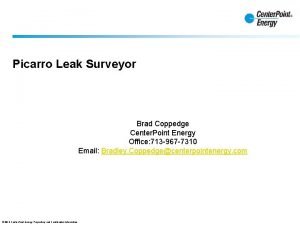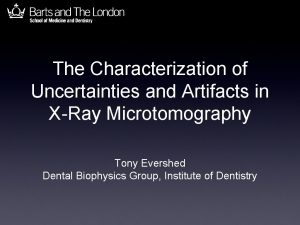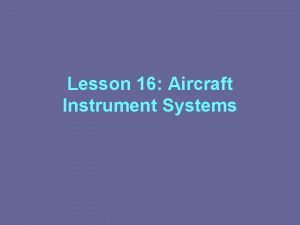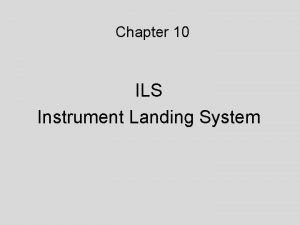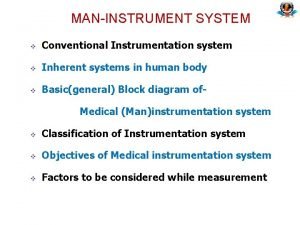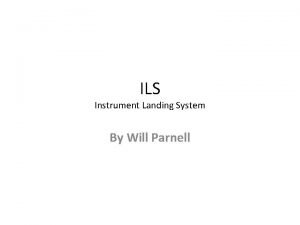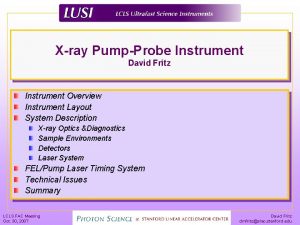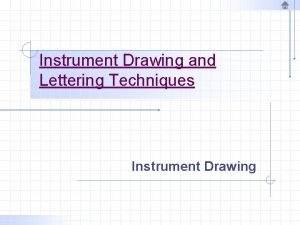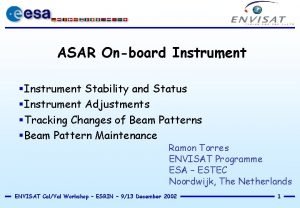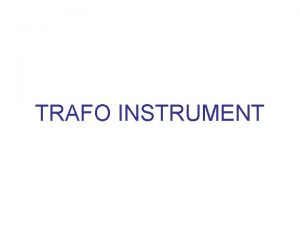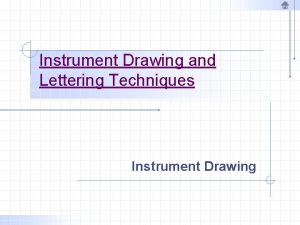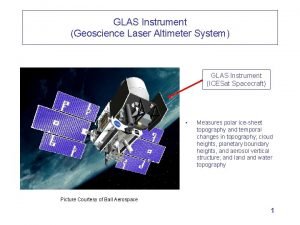Instrument characterization discussion Characterization of Picarro system Characterization










- Slides: 10

Instrument characterization discussion • • • Characterization of Picarro system Characterization of closed-path Licor systems (hybrid 7500 and the 7200) Other instruments…

Picarro G 1301 • based on Wavelength. Scanned Cavity Ring. Down Spectroscopy (WS-CRDS) • Precision (@5 sec) CO 2 <0. 2 ppmv CH 4 <1 ppbv H 2 O 100 ppmv • More stable • The “perfect” instrument? Licor LI-7500 A LI-7200 • based on non-dispersive infrared (NDIR) measurements • Precision (@10 Hz) CO 2 0. 11 ppmv H 2 O 0. 0047 pptv • spectral interferences and motion problems.

Sensor resolution requirements? To limit at 10% the contribution of sensor noise to uncertainty in flux measurement by eddy covariance : Rowe, M. D. , Fairall, C. W. , and Perlinger, J. A. : Chemical sensor resolution requirements for nearsurface measurements of turbulent fluxes, Atmos. Chem. Phys. Discuss. , 10, 24409 -24433, doi: 10. 5194/acpd-10 -24409 -2010, 2010. with R sensor resolution requirement αc dimensionless solubility of C water-air difference in concentration kc air-water transfer velocity of scalar C [m s-1]

• Example: at a height of 18 m, wind speed 8 m s-1, u* = 0. 28 m s-1, f. Nyquist = 5 Hz, and neutral stability (z/L = 0). • APcov' = 161 for covariance CPc CO 2 1. 7 E-04 DMS 1. 8 E-03 Acetone 2. 0 E-02 SO 2 3. 5 E-03 CO 5. 6 E-06 O 3 6. 3 E-05 R/ΔC 2. 7 E-03 2. 9 E-02 3. 2 E-01 5. 6 E-02 9. 0 E-05 1. 0 E-03 If ΔCDMS = 2. 0 ppbv R = 0. 058 ppbv If ΔCCO 2 = 20 ppmv R = 0. 054 ppmv If ΔCCO 2 = 100 ppmv R = 0. 27 ppmv

Other things to consider… Open path & Closed-path: • Response time • Sensitivities Closed-path: • Flow in turbulent regime (Re>2300) • Lag time (use of a ‘puff system’) • Residence time in measurement cell • Attenuation effects due to sample line, cell, dryer, … • Water vapor effects: WPL vs Nafion membrane dryer? • Inlet filters or regular line cleanings?

Example of Picarro instrument issues… 1) Evaluation of CO 2 cospectra from Cal. Nex. Can the instrument in it's current configuration see the CO 2 flux when p. CO 2 is large at moderate wind speeds? 2) Water vapor correction. • poor performance of the Picarro H 2 O measurement need to evaluate the effect of a Nafion dryer on the CO 2 signal. • Hopefully we can remove the water signal and avoid the need for a correction.

3) Investigation of the high frequency response characteristics. What causes the strange pattern in the high frequency variance spectrum? Is motion an issue? If so, is the motion affecting pressure control, optical elements, or something else?

And with Chris’ magic (example time series with large sea-air temperature and humidity differences so that measurements of temperature and humidity fluctuations well above instrument noise levels) CO 2 variance spectra. Corrected Licor spectra agree with the Picarro spectrum. w-c cospectra versus frequency: raw Licor w-c cospectrum (blue), the Picarro w-c cospectrum (dashed), corrected spectrum as per formula below is green; the w-( cm’-µq’) cospectrum is red.

Objectives 1. Tests to optimize the instruments performance: • In the laboratory: response time, sensitivities, frequency response, motion simulation… • Outside test like at the Table Mountain research facility north of Boulder, CO for instance. Purpose: significant H 2 O/CO 2 flux for frequency response study 2. Integration of the specific instruments into flux system 3. Deployment and testing during cruises (real motion simulation). 4. Analysis of fluxes and more.

Other topics SW DMS: • • UH will build a smaller version of their DMS APIMS dedicated to sea water measurements. Already have a small mass spectrometer for this purpose Byron currently working on the design modifications necessary for APIMS conversion. It would be desirable to get a collaborative cruise with someone (Steve Archer? ) using the traditional GC measurement for DMS as validation for the new measurement. CO: • • Need to evaluate the performance of the LGR CO instrument for CO flux. Need to put together a seawater measurement for CO. Equilibrator: • • Needed for seawater measurements of CO 2 and CO. Existing technology and not too expensive to build (what do we need to develop system? Requirements? ) We can address this early next year and test on the first cruise. Need to buy or borrow a closed path Licor for the p. CO 2 measurement. Other: Acetone, SO 2, etc… ?
 Centerpoint energy
Centerpoint energy Picarro wikipedia
Picarro wikipedia Introduction of fractional distillation
Introduction of fractional distillation Active and passive instruments pdf
Active and passive instruments pdf Characterization
Characterization Indirect characterization example
Indirect characterization example How does a turn coordinator work
How does a turn coordinator work Components of instrument landing system
Components of instrument landing system Man instrumentation system
Man instrumentation system Ils categories
Ils categories Instrument landing system localizer
Instrument landing system localizer
